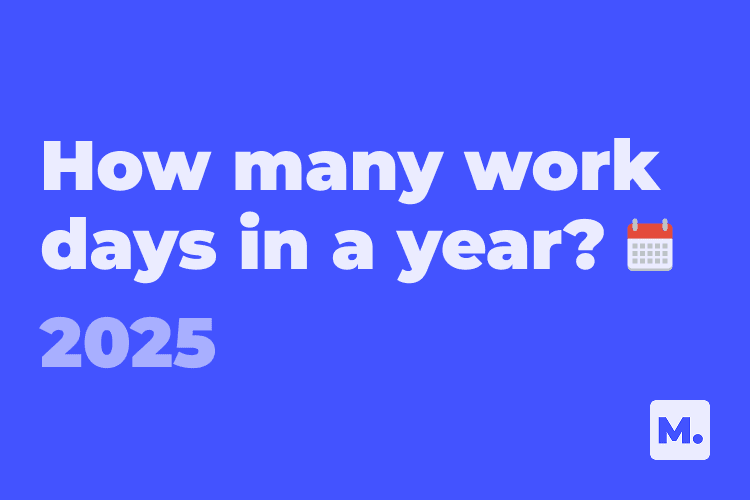As we navigate through 2025, understanding how many work days in a year is essential for effective planning, whether you’re managing a business, scheduling projects, or organizing personal time off.
This guide explores how many work days are in 2025, provides a monthly breakdown, accounts for federal holidays, and offers practical tips for planning your work schedule. We also include a simple method to calculate work days, address common questions, and consider non-traditional work schedules to help you make the most of your year.
- 1. The Evolution of the Work Week
- 2. Working Time Calendar for 2025
- 3. Why Knowing Work Days Matters
- 4. How to Calculate Working Days in 2025
- 5. Federal Holidays in 2025
- 6. Work Hours in 2025
- 7. Understanding Non-Traditional Work Schedules
- 8. Tips for Planning Your 2025 Work Schedule
- 9. FAQs
- 10. Conclusion
The Evolution of the Work Week
The modern work week has a rich history. In the early 20th century, workers often endured six-day weeks with 12-hour shifts. The shift to a five-day, 40-hour work week began with Henry Ford, who found that giving workers weekends off boosted productivity and morale.
This change was formalized in the United States with the Fair Labor Standards Act of 1938, establishing the 40-hour work week as a standard. Today, flexible schedules and remote work are reshaping how we approach work. For tools to manage your career, see the Career Maintenance Checklist.
Working Time Calendar for 2025
2025 is a non-leap year with 365 days, starting and ending on a Wednesday. There are 261 weekdays (Monday through Friday) and 104 weekend days (52 Saturdays and 52 Sundays). After subtracting 11 federal holidays, all of which fall on weekdays, the year has approximately 250 business days.
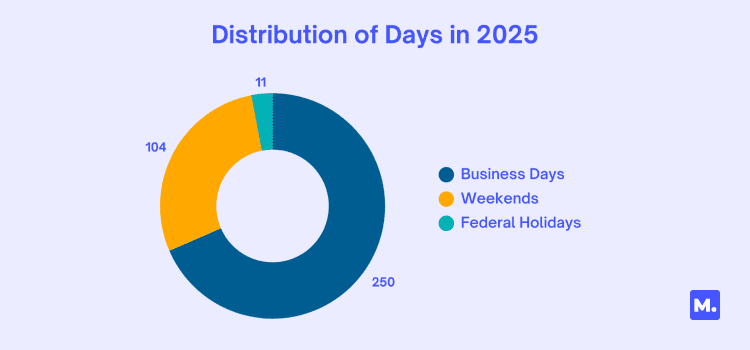
Comparison of Work Days in Recent Years
To illustrate how the number of work days can vary slightly year by year, here’s a quick look:
- 2025: 250 business days
- 2024 (Leap Year): 251 business days (366 total days, same number of weekends, but different holiday distribution)
- 2023: 250 business days
- 2022: 251 business days
Below is a detailed breakdown of working days per month in 2025:
| Month | Working Days (Mon-Fri) | Business Days (Mon-Fri – Federal Holidays) | Weekends | Working hours monthly | Holidays (Falling on Weekday) |
|---|---|---|---|---|---|
| January 1-31 | 23 | 21 | 8 | 168 | Wednesday, Jan 1 – New Year’s Day; Monday, Jan 20 – MLK Day |
| February 1-28 | 20 | 19 | 8 | 152 | Monday, Feb 17 – Washington’s Birthday |
| March 1-31 | 21 | 21 | 10 | 168 | – |
| April 1-30 | 22 | 22 | 8 | 176 | – |
| May 1-31 | 22 | 21 | 9 | 168 | Monday, May 26 – Memorial Day |
| June 1-30 | 21 | 20 | 9 | 160 | Thursday, June 19 – Juneteenth National Independence Day |
| July 1-31 | 23 | 22 | 8 | 176 | Friday, July 4 – Independence Day |
| August 1-31 | 21 | 21 | 10 | 168 | – |
| September 1-30 | 22 | 21 | 8 | 168 | Monday, Sep 1 – Labor Day |
| October 1-31 | 23 | 22 | 8 | 176 | Monday, Oct 13 – Columbus Day |
| November 1-30 | 20 | 18 | 10 | 144 | Tuesday, Nov 11 – Veterans Day; Thursday, Nov 27 – Thanksgiving Day |
| December 1-31 | 23 | 22 | 8 | 176 | Thursday, Dec 25 – Christmas Day |
| Total | 261 | 250 | 104 | 2000 | 11 |
For a monthly perspective, learn how many work days in a month.
Business days Per Month in 2025
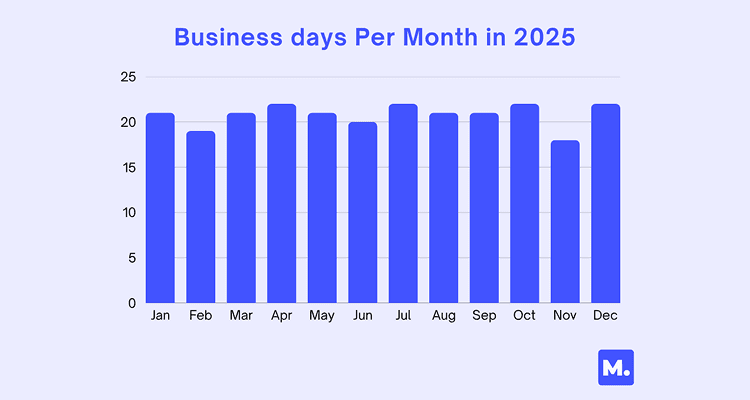
Why Knowing Work Days Matters
Understanding the number of work days in 2025 is vital for several reasons:
- Project Planning: Accurate timelines ensure realistic deadlines and efficient resource allocation.
- Payroll Accuracy: Correct workday counts are essential for calculating salaries, especially for hourly employees.
- Vacation Scheduling: Knowing work days helps plan time off without disrupting critical work periods.
- Work-Life Balance: A clear work schedule supports better time management, enhancing work-life balance.
- Business Capacity Planning: For businesses, understanding the total available workdays is crucial for forecasting productivity, setting realistic goals, and managing staffing levels throughout the year.
- Legal Compliance: Ensuring adherence to labor laws regarding working hours, overtime, and holiday pay.
How to Calculate Working Days in 2025
Calculating work days in 2025 is straightforward:
- Total Days: Start with 365 days.
- Subtract Weekends: There are 52 weeks, each with 2 weekend days (Saturday and Sunday), totaling 104 days. (The extra day in 2025, December 31, is a Wednesday, so it doesn’t affect the weekend count).
- Subtract Federal Holidays: There are 11 federal holidays, all on weekdays.
Calculation:
Total Business Days = 365 (Total Days) – 104 (Weekends) – 11 (Federal Holidays) = 250
Workday Calculator
For precise calculations, especially for specific periods or regions, online workday calculators are invaluable. These tools account for weekends, federal holidays, and sometimes state-specific holidays. A reliable option is the calendar provided by LeaveBoard, which offers customizable calculations for work days and hours. You can also leverage calendar apps with holiday overlays or features in project management and payroll software. Always check official state government websites for state-specific holidays that might impact your local workday count.
Federal Holidays in 2025
The United States observes 11 federal holidays in 2025, all falling on weekdays:
- New Year’s Day: January 1 (Wednesday)
- Martin Luther King Jr. Day: January 20 (Monday)
- Washington’s Birthday: February 17 (Monday)
- Memorial Day: May 26 (Monday)
- Juneteenth National Independence Day: June 19 (Thursday)
- Independence Day: July 4 (Friday)
- Labor Day: September 1 (Monday)
- Columbus Day: October 13 (Monday)
- Veterans Day: November 11 (Tuesday)
- Thanksgiving Day: November 27 (Thursday)
- Christmas Day: December 25 (Thursday)
Note that Inauguration Day (January 20) coincides with Martin Luther King Jr. Day and is observed only in specific areas, so it’s not counted separately nationwide. For a complete list, see FederalPay – Federal Holidays.
Work Hours in 2025
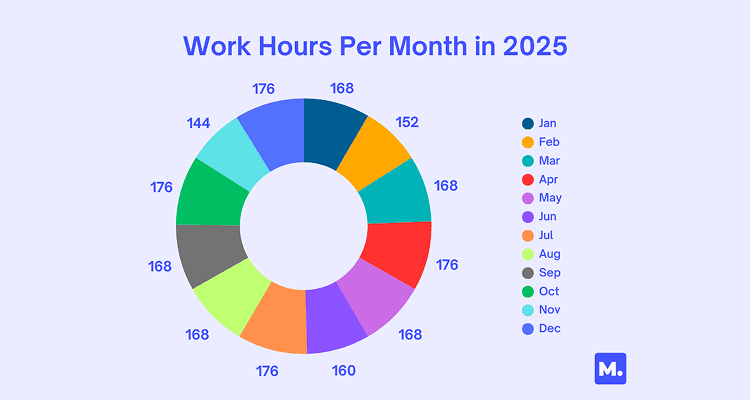
Assuming a standard 8-hour workday, the total work hours in 2025 are:
- Total Business Days: 250
- Hours per Day: 8
- Total Hours: 250 × 8 = 2,000 hours
This excludes overtime, vacation days, or additional time off. For insights on managing work hours, see how many work weeks in a year.
Accounting for Paid Time Off (PTO)
The 250 business days represent the maximum potential workdays. However, your actual number of work days will be lower once you factor in personal paid time off (PTO), which typically includes vacation days, sick days, and personal days.
For example, if you have:
- 250 Business Days (calculated above)
- – 10 Vacation Days
- – 5 Sick Days
- = 235 Actual Work Days
Always deduct your allocated PTO from the total business days to get a more accurate picture of your individual working days.
Understanding Non-Traditional Work Schedules
While we focus on the standard Monday-to-Friday work week, it’s important to acknowledge that “work days” can vary significantly for individuals on non-traditional schedules:
- Four-Day Work Week (4/10s): If you work four 10-hour days (e.g., Monday-Thursday), your count of work days in a year would be approximately 4/5ths of the standard 250 business days, or around 200 days, but with longer hours per day.
- Compressed Work Weeks (e.g., 9/80): In a 9/80 schedule, you work nine 9-hour days over two weeks, getting every other Friday off. This slightly reduces your total work days compared to a standard five-day week, but the total hours typically remain consistent.
- Shift Workers: Many industries (e.g., healthcare, retail, manufacturing) operate 24/7. For shift workers, “work days” are defined by their rostered shifts, which can include weekends and federal holidays. Their personal planning revolves around their specific shift patterns rather than the traditional weekday calendar.
- Part-Time Workers: If you work part-time (e.g., 3 days a week), your total work days would be a fraction of the 250 business days. For instance, 3/5ths of 250 days would be approximately 150 work days.
These variations highlight the importance of personalizing the “work days” calculation based on your specific employment agreement.
Tips for Planning Your 2025 Work Schedule
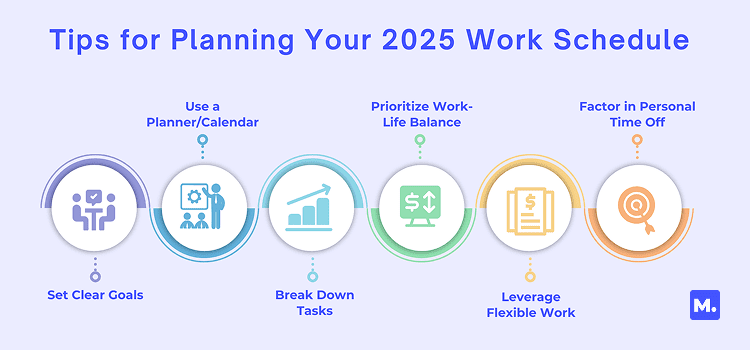
- Set Clear Goals: Define professional and personal objectives for 2025 to stay focused.
- Use a Planner/Calendar: Track deadlines, holidays, and personal commitments with tools like the Career Maintenance Tracker, or digital calendars that allow you to overlay federal and state holidays.
- Break Down Tasks: Divide large projects into smaller, manageable tasks to maintain progress and avoid feeling overwhelmed.
- Prioritize Work-Life Balance: Actively allocate time for rest, hobbies, and recreation to avoid burnout and maintain overall well-being.
- Leverage Flexible Work: If applicable, explore flexible work options like remote work, which can offer greater flexibility in managing your schedule and personal time.
- Factor in Personal Time Off: When planning projects or personal events, always consider your individual vacation and sick days to ensure realistic timelines.
FAQs
How many work days are in 2025?
There are approximately 250 business days in 2025, excluding weekends and federal holidays.
How many federal holidays are in 2025?
There are 11 federal holidays in 2025, all on weekdays.
Does the number of work days change every year?
Yes, the number varies slightly due to the distribution of weekends and holidays. Leap years or holidays falling on weekends can alter the count.
How many work weeks are in a year?
On average, there are 52 work weeks, but this can vary slightly based on the year’s structure.
How can I calculate work days for my specific state?
Federal holidays are consistent nationwide, but state holidays vary. Check state-specific calendars (usually found on your state’s government official website) to account for additional holidays.
How many work hours are in 2025?
For a standard 8-hour workday, there are approximately 2,000 work hours (250 days × 8 hours), before considering personal time off.
Does Sunday count as a work day?
Typically, Sunday is considered a weekend day and not a work day in a standard Monday-to-Friday schedule. For shift workers, it may be a scheduled work day.
How many paid days off do I get a year?
Paid time off varies by employer and your length of service. Federal employees typically receive the 11 federal holidays, plus additional vacation and sick days. Consult your employer’s HR policy for specifics.
How do non-traditional work schedules affect the number of work days?
For schedules like 4-day work weeks or part-time work, the total number of work days will be proportionally lower than the standard 250 business days, although the total hours worked annually might remain similar.
Is this information applicable internationally?
This guide is specific to the United States federal holiday schedule. The number of work days and observed holidays varies significantly by country.
Conclusion
Knowing how many work days are in 2025 empowers you to plan effectively, whether for business, personal projects, or maintaining a healthy work-life balance. With 250 potential business days, 11 federal holidays, and tools like online calculators, you can optimize your schedule for productivity and well-being. Use this guide, along with resources like work-life balance statistics, to make 2025 a successful year, tailored to your unique work situation.

Hlib, Editor-in-Chief at Made for Lives, writes in-depth guides on jobs, careers, and work-life balance to help readers thrive professionally.

